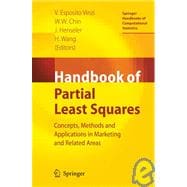
| Methods: PLS Path Modeling: Concepts, Model Estimation and Assessment: Latent Variables and Indicators: Herman Wold's Basic Design and Partial Least Squares | |
| PLS Path Modeling: Recent Developments and Open Issues for Model Assessment and Improvement | |
| Bootstrap Cross-Validation Indices for PLS Path Model Assessment | |
| PLS Path Modeling: Extensions: How to use PLS Path modeling for analyzing multi-block data sets | |
| How to use ULS-SEM and PLS-SEM to measure interaction effect in a regression model relating two blocks of binary variables | |
| A new Multiblock PLS based method to estimate causal models | |
| Application to the post-consumption behaviour in tourism | |
| A Permutation Based Procedure for Multi-Group PLS Analysis: Results of Tests of Differences on Simulated Data and a Cross of Information System Services between Germany and the USA | |
| Looking at the Antecedents of Perceived Switching Costs G¼" A PLS Path Modeling Approach with Categorical Indicators | |
| PLS Path Modeling with Classification Issues: The Finite Mixture Partial Least Squares Approach - Methodology and Application | |
| Prediction-oriented classification in PLS Path Modelling | |
| Conjoint use of variables clustering and PLS structural equations modelling | |
| PLS Path Modeling for Customer Satisfaction Studies: Design of PLS-based Satisfaction Studies | |
| Applying Bootstrap and Structural Equation Models to a Customer Satisfaction Model on Mobile Telecommunications Sector | |
| Comparison of Likelihood and PLS estimators for Structural Equation Modeling | |
| A Simulation with Customer Satisfaction Data | |
| Modeling Customer Satisfaction: A Comparative Performance Evaluation of Covariance Structure Analysis versus Partial Least Squares | |
| PLS Regression: PLS and Data Mining | |
| Three-block data modeling by endo- and exo-LPLS Regression | |
| Regression Modeling Analysis on Compositional Data | |
| A Modification of the PLSR Method | |
| Applications to Marketing and Related Areas: PLS and Success Factor Studies in Marketing | |
| Applying Maximum Likelihood and PLS on Different Sample Sizes: Studies on Servqual Model and Emloyee Behaviour Model | |
| A PLS Model to Study Brand Preference: An Application to a Product Class | |
| An Application of PLS in Multi-Group Analysis: The need for differentiated corporate-level marketing in the mobile communications industry | |
| Modelling the Impact of Corporate Reputation on Customer Satisfaction and Loyalty Using PLS | |
| Reframing Customer Value in a Service-based Paradigm: An Evaluation of a Formative Measure in a Multi-Industry, Cross-Cultural Context | |
| Analyzing factorial data using PLS: Application in an online complaining context | |
| Content Strategies in the Internet | |
| Use of Partial Least Squares (PLS) in TQM Research: TQM Practices and Business Performance in SMEs | |
| Using PLS to Investigate Interaction Effects Between Higher Order Branding Constructs | |
| Tutorials with Didactic Approach: How to Write Up and Report PLS analyses | |
| On the Operalization of Constructs in Multiple Groups | |
| Evaluation of Structural Equation Models using the Partial Least Squares (PLS-) Approach | |
| PLS and Confirmatory Tetrad Testing for Formative Measurement Scales in Marketing | |
| Testing Moderating Effects in PLS Path Models: An Illustration of Available Procedures | |
| A Comparison of Current PLS Path Modeling Software - Features, Ease-of-Use, and Performance | |
| PLS Regression Modeling with Qualitative Variables and Its Application to Beijing Sand Storm Prevention | |
| Interpretation of the preferences of automotive customers applied to air conditioning supports by combining GPA and PLS regression | |
| Table of Contents provided by Publisher. All Rights Reserved. |
The New copy of this book will include any supplemental materials advertised. Please check the title of the book to determine if it should include any access cards, study guides, lab manuals, CDs, etc.
The Used, Rental and eBook copies of this book are not guaranteed to include any supplemental materials. Typically, only the book itself is included. This is true even if the title states it includes any access cards, study guides, lab manuals, CDs, etc.